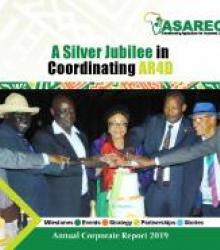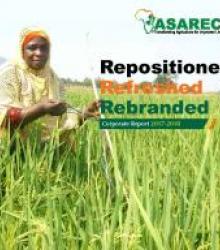| Title | Author | Asbract |
|---|---|---|
| Beef products in East and Central Africa | ASARECA | Quality and safety of small scale beef products in East and Central Africa. |
| Natural Resources Management and Biodiversity | ASARECA | In response to the above challenges, the Natural Resource Management and Biodiversity Programme has, in a consultative manner, identified strategic interventions to promote the use of appropriate technologies and innovations in management of the sub-region,s natural capital. The key strategic interventions are.... |
| Agrobiodiversity and Biotechnology Programme | ASARECA | Since 2008, the programme has used biotechnology to enhance the use of agro-biodiversity and as a platform to develop new knowledge. Working with partners from eight national agricultural research institutes (NARIS) and the private sector in Uganda, Sudan, Kenya, Tanzania, Burundi, Ethiopia, Eritrea, D.R.Congo, the project has scored the following achievements |
| Livestock and Fisheries Programme | ASARECA | |
| High Value Non Staple Crops Programme | ASARECA | The importance of high value non-staple-crops cannot be overstated. Non-staple crops are a crucial source of nutrition and good health. More than ever before, nutrition and good health are becoming major issues worldwide. Besides, high value non-staple crops are increasingly proving to be top-notch income earners for households. It is for this reason that the programme was initiated to prioritize research in these crops. |
| Eastern Africa Plant Genetic Resources Network | ASARECA | As part of measures to address the challenge of climate change on worldÔÇÖs food production and agriculture, scientists recommend to search for genes in wild and traditional varieties of common food crops that could help plants to adapt to variable weather conditions, resist pest and disease, tolerate drought and produce sustainable yield. For this to happen, crop diversity must be properly conserved and easily accessed.. |
| Staple Crops Programme | Staple crops are a crucial source of food, feed, raw materials, improved nutrition and employment and are a major source of income. The Staple Crops Programme focuses on banana, cassava, maize, millet, potato, rice, sorghum, sweetpotato and wheat, which are priority staples in the region. |
|
| ASARECA working to deliver the CAADP agenda | ASARECA | ASARECA sees improved delivery and impact of scientific knowledge, policy options and technologies as a powerful instrument to drive the sub-region towards meeting the Comprehensive African Agricultural Development Program (CAADP) which is the agricultural agenda of the African Union's, New Economic Partnership for African Development (AU/NEPAD). |
| Functions of ASARECA | ASARECA | Develop a shared vision and sub-regional goals |
| Describes ASARECA Vision and Mission | ASARECA | The Association for Strengthening Agricultural Research in Eastern and Central Africa (ASARECA) is a sub-regional not-for-profit association. It was established in 1994 by ten member countries represented by their national agricultural research for development institutes. The 10 member countries are: Burundi, Democratic Republic of Congo, Eritrea, Ethiopia, Kenya, Madagascar, Rwanda, Sudan, Tanzania, and Uganda. |
| Establishment, management and use of Calliandra calothyrusus (Calliandra) | ASARECA | Calliandra is a multipurpose tree species grown primarily for forage as a supplement to low quality roughages for ruminant livestock. It a source of green manure; provides shade for coffee and tea, stakes for climbing beans, is a source of wood fuel for cooking; controls soil erosion, and is a source of pollen for honey production.Calliandra leaf hay is a potential source of income as the demand for hay is now very high. Leaf hay is used to make nutrient feed blocks in addition to other locally available materials such as molasses, maize bran, cotton seed cake, farm waste and crop residues |
| Impacts of an improved seed policy environment in Eastern and Central Africa | Michael Waithaka, Jonathan Nzuma, Miriam Kyotalimye, Obongo Nyachae | This discussion paper assesses the impacts of an improved seed policy environment in the Eastern and Central Africa (ECA) region using a case study of formal trade in seed maize in Kenya, Uganda and Tanzania that employs a spatial equilibrium model (SEM). The data used in this study was derived from a regional survey of key informants undertaken in August 2009. It is complimented by secondary data on seed production, consumption, prices and elasticity parameter estimates that were derived from various sources. The quantification of the trade and welfare impacts of seed policy harmonization involved a before and after comparative analysis. The paper commences by reviewing the progress made in the harmonization of seed policies in ECA region with regard to five thematic areas agreed for harmonization. |
| Annex to the Paper: Responding to the Food Price Crisis in Eastern and Southern Africa | ASARECA | This is the Annex to the paper entitled "Responding to the Food Price Crisis in Eastern and Southern Africa" |
| Responding to the Food Price Crisis in Eastern and Southern Africa | ASARECA | This paper addresses the magnitude and implications of food price changes in national and regional markets in Eastern and Southern Africa with a view to provide the evidence base for effective policy action. |
| Celebrating the International Day of Biodiversity | Dr. Abebe Demissie | Realizing the strategic importance of this day to the attainment of ASARECAs ultimate objective to Improve Livelihoods, ASARECA member countries celebrate the Worlds Biodiversity Day by organizing various forums including national discourse, workshops, public discussions and exhibitions, among other activities. The activities highlight the role of biodiversity in ensuring that people have sustainable access to adequate and nutritive food to lead active and healthy lives and sustain ecosystem goods and services and promote socio-economic development. |
Search
Search entail eLibrary collection
Copyright © 2025. All rights reserved.
Designed By ASARECA


